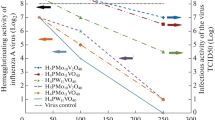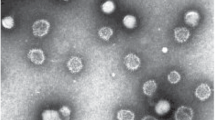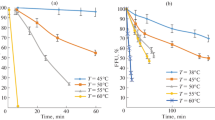Summary
Adsorption of paramyxoviruses to separated membranes of tumor cells produces neoantigens that are immunogenic in syngeneic mice (xenogenization). Thus it became possible to study this process by using modified virus or virus fractions. Membranes with adsorbed viral derivatives produced an immune response which was measured by cytotoxic and complement fixing antibodies and the appearance of autoimmune disease. The effect of viral preparations with reduced F (fusion) protein activity was compared to treatment of membranes with equivalent amounts of active or inactive virus as measured by hemagglutination. Viral preparations without hemolytic activity showed diminished adsorption to membranes and the immune response was reduced. Triton X100 and desoxycholate extracted from membranes immunogenic material with associated paramyxovirus antigens.
Similar content being viewed by others
References
Almquist, S. J. P., Eaton, M. D.: Cell mediated immunity in mice immunized with modified syngeneic Gross lymphoma antigen. Cell. Immunol.37, 383–389 (1978).
Eaton, M. D., Heller, J. A., Scala, A. R.: Enhancement of lymphoma cell immunogenicity by infection with nononcogenic virus. Cancer Res.33, 3293–3298 (1973).
Eaton, M. D., Almquist, S. J. P.: Antibody response of syngeneic mice to membrane antigens from NDV-infected lymphoma. Proc. Soc. exp. Biol. Med.148, 1090–1094 (1975).
Eaton, M. D., Almquist, S. J. P.: Autoimmunity induced by injection of virus-modified cell membrane antigens in syngeneic mice. Infect. Immun.15, 322–328 (1977).
Eaton, M. D., Almquist, S. J. P.: Tumor immunity and autoimmunity produced by injection of antigens modified by adsorbed virus. (In preparation.)
Hosaka, Y., Shimizu, Y. K.: Artificial assembly of envelope particles of HVJ (Sendai virus). 1. Assembly of hemolytic and fusion factors from envelopes solubilized by Nonidet P 40. Virology49, 627–640 (1972).
Hopel, A. J., Bablanian, R., Cole, G. A.: Inductive requirements for the generation of virus-specific T lymphocytes. 1. Nature of the host cell-virus interaction that triggers the secondary poxvirus-specific cytotoxic T lymphocyte induction. J. Immunol.121, 736–743 (1978).
Howe, C., Morgan, C.: Interaction between Sendai virus and human erythrocytes. J. Virol.3, 70–81 (1969).
John, T. J., Fulginiti, V.: Parainfluenza 2 virus: increase in hemagglutinin titer on treatment with Tween-80 and ether. Proc. Soc. exp. Biol. Med.121, 109–112 (1966).
Kobayashi, H., Kodama, T., Gotohda, E.: Xenogenization of tumor cells. Hokkaido University Medical Library Series 9 (1977).
Lindenmann, J., Klein, P. A.: Viral oncolysis. Increased immunogenicity of host cell antigens associated with influenza virus. J. exp. Med.126, 93–108 (1967).
Morrison, T. G., McQuain, C.: Assembly of viral membranes. 1. Association of vesicular stomatitis virus membrane proteins and membranes in a cell free system. J. Virol.21, 451–458 (1977).
Neff, J. M., Enders, J.: Poliovirus replication and cytopathogenicity in monolayer hamster cell cultures fused with β-propiolactone inactivated Sendai virus. Proc. Soc. exp. Biol. Med.127, 260–267 (1968).
Norrby, E.: Hemagglutination by measles virus. A simple procedure for production of high potency antigen for hemagglutination-inhibition (HI) tests. Proc. Soc. exp. Biol. Med.111, 814–818 (1962).
Orvell, C., Norrby, E.: Immunologic properties of purified Sendai virus glycoproteins. J. Immunol.119, 1882–1887 (1977).
Roesing, T. G., Toselli, P. A., Crowell, R. L.: Elution and uncoating of Coxsackievirus B3 by isolated HeLa cell plasma membranes. J. Virol.15, 654–667 (1975).
Scheid, A., Choppin, P.: Identification of biologic activities of paramyxovirus glycoprotein. Activation of cell fusion, hemolysis and infectivity by proteolytic cleavage of an inactive precursor. Virology57, 475–490 (1974).
Scheid, A., Choppin, P.: Isolation and purification of the envelope proteins of Newcastle disease virus. J. Virol.11, 263–271 (1973).
Shimizu, K., Hosaka, Y., Shimizu, Y. K.: Solubilization of envelopes of HVJ (Sendai virus) with alkali-emasol treatment and reassembly of envelope particles with removal of detergent. J. Virol.9, 842–850 (1972).
Sugamura, K., Shimizu, K., Bach, F. H.: Involvement of fusion activity of ultraviolet light-inactivated Sendai virus in formation of target antigens recognized by cytotoxicT cells. J. exp. Med.148, 276–287 (1978).
Kozinowski, U., Gething, M. J., Waterfield, M.: T-cell cytotoxicity in the absence of viral protein synthesis. Nature267, 160–163 (1977).
Author information
Authors and Affiliations
Rights and permissions
About this article
Cite this article
Eaton, M.D. Role of envelope proteins of paramyxoviruses in the modification of cell membrane antigens. Archives of Virology 61, 327–336 (1979). https://doi.org/10.1007/BF01315020
Received:
Accepted:
Issue Date:
DOI: https://doi.org/10.1007/BF01315020




